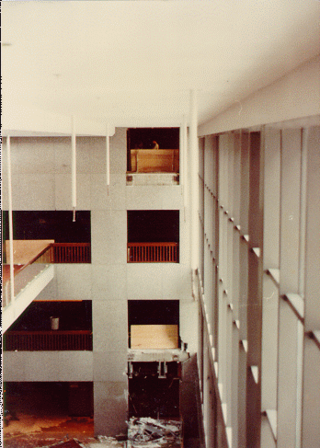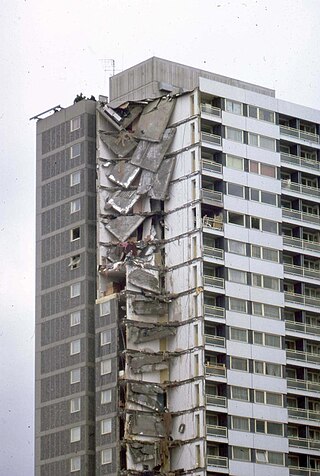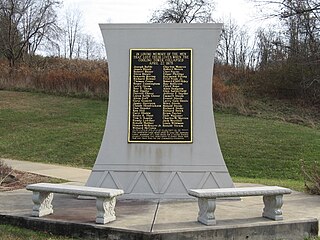
Structural engineering is a sub-discipline of civil engineering in which structural engineers are trained to design the 'bones and muscles' that create the form and shape of human-made structures. Structural engineers also must understand and calculate the stability, strength, rigidity and earthquake-susceptibility of built structures for buildings and nonbuilding structures. The structural designs are integrated with those of other designers such as architects and building services engineer and often supervise the construction of projects by contractors on site. They can also be involved in the design of machinery, medical equipment, and vehicles where structural integrity affects functioning and safety. See glossary of structural engineering.

The collapse of the World Trade Center occurred on Tuesday, September 11, 2001, after two commercial airliners hijacked by Al-Qaeda terrorists were deliberately flown into the Twin Towers of the World Trade Center complex in New York City as part of the September 11 attacks. The North Tower was the first building to be hit when American Airlines Flight 11 crashed into it at 8:46 a.m., causing it to collapse at 10:28 after burning for one hour and 42 minutes. At 9:03 a.m., the South Tower was struck by United Airlines Flight 175; it collapsed at 9:59 a.m. after burning for 56 minutes. The towers' destruction caused major devastation throughout Lower Manhattan, and more than a dozen adjacent and nearby structures were damaged or destroyed by debris from the plane impacts or the collapses. Four of the five remaining World Trade Center structures were immediately crushed or damaged beyond repair as the towers fell, while 7 World Trade Center remained standing for another six hours until fires ignited by raining debris from the North Tower brought it down at 5:21 that afternoon. The hijackings, crashes, fires and subsequent collapses killed an initial total of 2,760 people. Toxic powder from the demolished high-rises was dispersed throughout the city and gave rise to numerous long-term health effects that continue to plague many who were in the towers' vicinity, with at least three additional deaths reported. The 110-story towers are the tallest freestanding structures ever to be destroyed, and the death toll from the attack on the North Tower represents the deadliest terrorist act in world history.

On July 17, 1981, the Hyatt Regency Hotel in Kansas City, Missouri, suffered the structural collapse of two overhead walkways. Loaded with partygoers, the concrete and glass platforms cascaded down, crashing onto a tea dance in the lobby, killing 114 and injuring 216. Kansas City society was affected for years, with the collapse resulting in billions of dollars of insurance claims, legal investigations and city government reforms.

Ronan Point was a 22-storey tower block in Canning Town in Newham, East London, that partly collapsed on 16 May 1968, only two months after it had opened. A gas explosion blew out some load-bearing walls, causing the collapse of one entire corner of the building; four people died and 17 were injured. The spectacular nature of the failure led to a loss of public confidence in high-rise residential buildings, and major changes in British building regulations resulted.
The Connecticut Turnpike is a freeway and former toll road in the U.S. state of Connecticut; it is maintained by the Connecticut Department of Transportation (ConnDOT). Spanning approximately 128 miles (206 km) along a generally west–east axis, its roadbed is shared with Interstate 95 (I-95) for 88 miles (142 km) from the New York state border in Greenwich to East Lyme; I-395 for 36 miles (58 km) from East Lyme to Plainfield; and State Road 695 (SR 695) for four miles (6.4 km) from Plainfield to the Rhode Island state line at U.S. Route 6 (US 6) in Killingly. The turnpike briefly runs concurrently with US 1 from Old Saybrook to Old Lyme and Route 2A from Montville to Norwich.
Thornton Tomasetti is a global, 1,500-plus person scientific and engineering consulting firm.
Dr. W. Gene Corley, P.E. was an American structural engineer and "preeminent expert on building collapse investigations and building codes." Corley was the Senior Vice President of CTLGroup from 1987 to 2013, where he led structural engineering projects, including numerous evaluations of buildings and structures damaged by earthquake, explosions, and from terrorist attacks. He led the investigation of structural performance of the Murrah Building following the Oklahoma City bombing in 1995, and the World Trade Center Building Performance Study in 2001–2002 following the September 11, 2001 attacks. He died on March 1, 2013. He was 77.

On March 2, 1973, the 26-story Skyline Plaza condominium building, under construction in Bailey's Crossroads in Fairfax County, Virginia, collapsed, killing 14 construction workers and injuring 35 others.
Robert Carmine Zampano was a United States district judge of the United States District Court for the District of Connecticut.

Progressive collapse is the process where a primary structural element fails, resulting in the failure of adjoining structural elements, which in turn causes further structural failure.
Warren William Eginton was an American jurist who served as a United States district judge of the United States District Court for the District of Connecticut.

The Willow Island disaster was the collapse of a cooling tower under construction at the Pleasants Power Station at Willow Island, West Virginia, on April 27, 1978. 51 construction workers were killed. It is thought to be the deadliest construction accident in U.S. history.
Thomas William Bucci is an American lawyer and former mayor of Bridgeport, Connecticut. A member of the Democratic Party, Bucci ran in 1985 and defeated incumbent mayor Leonard S. Paoletta flipping Bridgeport's leadership from Republican to Democratic. Bucci served two terms in office until he was defeated and succeeded by Mary C. Moran thus returning Bridgeport back to Republican leadership.
The Mianus River Bridge is a span that carries Interstate 95 over the Mianus River, between Cos Cob and Riverside, Connecticut. It is the second bridge on the site. The original bridge collapsed in 1983, killing three motorists. The replacement span is officially named the Michael L. Morano Bridge, after a state senator Michael L. Morano who represented Greenwich.

On June 29, 1995, the Sampoong Department Store in Seoul, South Korea, collapsed due to a structural failure. The collapse killed 502 people and injured 937, making it the largest peacetime disaster in South Korean history. It was the deadliest non-deliberate modern building collapse until the 2013 Rana Plaza factory collapse in Bangladesh.

Lift slab construction is a method of constructing concrete buildings by casting the floor or roof slab on top of the previous slab and then raising (jacking) the slab up with hydraulic jacks. This method of construction allows for a large portion of the work to be completed at ground level, negating the need to form floor work in place. The ability to create monolithic concrete slabs makes the lift slab construction technique useful in quickly creating structures with repetitive form work, like parking ramps.

Structural integrity and failure is an aspect of engineering that deals with the ability of a structure to support a designed structural load without breaking and includes the study of past structural failures in order to prevent failures in future designs.

The Bridgeport Fire Department provides fire protection and emergency medical services to the city of Bridgeport, Connecticut.

The Rana Plaza collapse was a structural failure that occurred on 24 April 2013 in the Savar Upazila of Dhaka District, Bangladesh, where an eight-story commercial building called Rana Plaza collapsed. The search for the dead ended on 13 May 2013 with a death toll of 1,134. Approximately 2,500 injured people were rescued from the building. It is considered the deadliest accidental structural failure in modern human history, the deadliest garment-factory disaster in history and the deadliest industrial accident in the history of Bangladesh.

Lev Zetlin was an Israeli-American civil and structural engineer. Founder of the engineering consulting firm Lev Zetlin & Associates, he developed several innovations in structural engineering including the double layer bicycle wheel roof system which he first employed at the Utica Memorial Auditorium and later patented. Zetlin was the structural engineer on 14 pavilions at the 1964–65 New York World's Fair including the New York State Pavilion which utilized his double layer cable suspended roof design.











